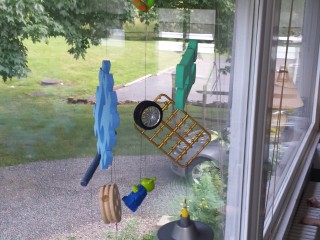Alexander Calder-inspired #toyhack sculpture
Type: Arts and crafts, Hacks and remixes
Inspired by the work of American sculptor Alexander Calder (who has been credited as the originator of the “mobile” as a type of kinetic sculpture) my two boys and I embraced the second #toyhack make-cycle as a team.
We worked on our Calder-inspired sculpture project together from beginning to end. First, I turned to the internet to introduce them to Alexander Calder and show them all kinds of examples of Calder’s work, focusing particularly on his mobiles. From there we were all charged up and jumped right into our own creative collaboration. We scoured their bedroom for old discarded toy “refuse” (lego pieces, tracks from an old train set, foam letters, glow-in-the-dark-jacks, tinker toy pieces, etc.). We looked for old pieces of things that seemed like garbage now. We talked about shapes, color, and texture, and throughout we were considering the idea of “re-purposing” what has been forgotten. The boys continually expressed nostalgia for pieces of things from their toddler or pre-school past. The collaboration then spurned them (without prompting, I swear ![]() to journal some of their current creative thoughts. They were drawing and mapping and writing as I was constructing the mobile. They were delighted when I started to arrange certain pieces and hold it up for pre-view. And they were very engaged in the particular placement of all the random found objects. It seemed to me that there was particular meaning in their sense of where things should go.
to journal some of their current creative thoughts. They were drawing and mapping and writing as I was constructing the mobile. They were delighted when I started to arrange certain pieces and hold it up for pre-view. And they were very engaged in the particular placement of all the random found objects. It seemed to me that there was particular meaning in their sense of where things should go.
This brief animoto video captures the surge of collaborative creativity that went into making our #toyhack for Make Cycle 2:
http://animoto.com/play/dkDfliZLl9pnxhL9iTpCxw
This vine clip gives you a sense of the kinetic quality of our #toyhack:
This was making at its best: it was fun, it was educational, it was inspiring and creative, it was mechanical and hands-on, and it spurned collective reflection. The sculpture now claims a corner window in our kitchen. I imagine that this process could be remixed in a variety of classroom settings, and one could anticipate a variety of student learning outcomes from the overall collaborative process.




